
This PDF was found in the the SUNY OER Community Course files.
- Subject:
- Education
- Law
- Material Type:
- Reading
- Provider:
- State University of New York
- Date Added:
- 01/08/2024

This PDF was found in the the SUNY OER Community Course files.

In this module we will provide a comprehensive description of the legal landscape of the assistive technology locally and on an international level as well as best practices.
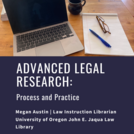
Written for students and instructors in an advanced legal research course, this book uses the steps of the legal research process to facilitate skills practice, collaboration, and reflection. It proposes a hypothetical as a basis for practicing the research process steps and encourages students and instructors to contribute other hypotheticals. The text also includes sample assignments, demonstration videos, and discussion and reflection questions, with opportunities for students and instructors to contribute additional questions. This text uses an approach that emphasizes student reflection on the development of research skills, with the benefit of repeated and consistent formative feedback.
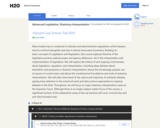
Most modern law is contained in statutes and administrative regulations, which lawyers tend to confront alongside case law in almost every area of practice. Building on basic concepts of Legislation and Regulation, this course explores theories of the legislative process, judicial power, and agency deference—all in the interpretation and implementation of legislation. We will explore the history of and ongoing controversies about legislation, regulation, and interpretation, including deep debates about textualism and purposive or dynamic interpretation; about the increasingly popular use of canons of construction; and about the constitutional foundations and ends of statutory interpretation. We will take close stock of the nature and trajectory of scholarly debates, paying close attention to the empirical work and data science approaches to ongoing debates in the field. Throughout, we will focus on major statutory interpretation cases at the Supreme Court. Although there is no single subject matter focus of the course, a significant portion of the substantive areas of law we traverse will cover criminal law and anti-discrimination law.

This is a syllabus for the course "The Age of Human Rights" (Capstone course – International Relations & International Law) designed for the University College Groningen (UCG), University of Groningen (the Netherlands). The syllabus is designed by taking into consideration the UCG’s focus on project-based education and it is further inspired by the design thinking approach to education.
This course aims to do two things. Firstly, to provide a good knowledge base on what international human rights are and what mechanisms exist to implement, supervise and enforce them. Secondly, to discuss in a critical manner how international human rights thinking has become inextricably linked to almost all areas of international cooperation. Students are asked to critically analyse specific human rights issues from a multi- or interdisciplinary perspective, thereby drawing upon information from the various disciplinary fields that they have covered in their programmes.
The first part of the course (6 sessions) is used to create the relevant knowledge base through interactive lectures. In the second part of the course (12 sessions), students are asked to work in small subgroups on particular issue areas which will be chosen in consultation with the instructors. The course concludes with a half-day conference on human rights in which the participating students act as panel members (this may be subject to change).
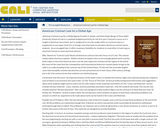
American Contract Law for a Global Age by Franklin G. Snyder and Mark Edwin Burge of Texas A&M University School of Law is a casebook designed primarily for the first-year Contracts course as it is taught in American law schools, but is configured so as to be usable either as a primary text or a supplement in any upper-level U.S. or foreign class that seeks to introduce American contract law to students. As an eLangdell text, it offers maximum flexibility for students to read either in hard copy or electronic format on most electronic devices.
Why “American” Contract Law? Nearly all American contract law texts focus on U.S. law. This volume simply makes that focus explicit. Modern American lawyers face an increasingly global world, and the book makes it clear that American law is not the only important commercial law regime in the world. But much of the value that the cosmopolitan and transnational American-trained lawyer brings to the table is an understanding of the contract law of the United States. To this end, the venerable English cases that exemplify common law doctrine are here presented not in their hoary 19th century settings. but in the 21st century forms that students can intuitively grasp.
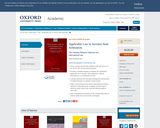
This text Provides a detailed analysis of whether the substantive applicable law in investor-state arbitration, national, international, or a combination of both.

This coursebook was created to support a course examining the experience of Asians and Asian Americans at various points in United States history. Three main areas of focus are immigration in the early 20th century, World War II, and the early 21st century.
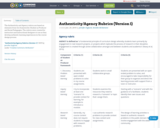
The Authenticity and Agency rubrics are based on elements from two frameworks: Student as Producer and Social Pedagogies. The rubrics were created for instructors and instructional designers to use as they develop authentic learning experiences in the course design process.
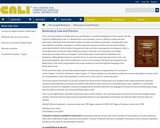
This is the third edition of Bankruptcy Law and Practice, a Casebook Designed to Train Lawyers for the Practice of Bankruptcy Law. It is designed for a one-semester course in debtor/creditor law and bankruptcy. The book deals with both creditor remedies and debtor protections, starting with state law collection remedies, exemptions, and the important special protections for secured creditors under both Article 9 of the Uniform Commercial Code and state real property recording acts. After a thorough review of state law debt collection practice, the book covers the basics of straight bankruptcy law with a focus on Chapter 7 of the Bankruptcy Code, both for individuals and businesses. Although the book has a practice focus, it covers the major Supreme Court cases, and important appellate cases with an emphasis on areas of uncertainty. The book also emphasizes the Bankruptcy Code itself, using problem sets to get students to work through the language of the Bankruptcy Code.
At the end of the book are two abbreviated chapters on bankruptcy reorganizations for consumers under Chapter 13 and for businesses under Chapter 11. These chapters are intended to outline the reasons that debtors choose to file for reorganization rather than liquidation, and focuses on the rules for confirming a plan.
The primary goal of the book is to prepare students for the practice of bankruptcy law. Students who understand these materials should be well prepared to anticipate and address the kinds of issues that arise in real bankruptcy cases, whether in a small dollar consumer practice or a big dollar corporate reorganization. Students will learn the language of commercial law and bankruptcy, along with the skills to find their way around the Bankruptcy Code.
This is a true digital book, with links to both the cases and the statutes. The case links jump to the full text in the free Google Scholar website, while the statutory links jump to reprinted statutes in the appendixes of the book. No materials other than the book are needed.
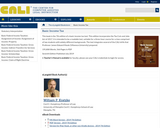
This book is the 7th edition of a basic income tax text. This edition incorporates the Tax Cuts and Jobs Act of 2017. It is intended to be a readable text, suitable for a three-hour course for a class comprised of law students with widely different backgrounds. The text integrates several of the CALI drills that Professor James Edward Maule (Villanova University) prepared.
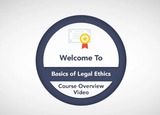
This course looks at the responsibilities of legal professionals (mainly lawyers) to defend their clients and to preserve the integrity of the justice system. While the course is mainly based on rules applicable to attorneys, non-attorney legal professionals who work with attorneys are also indirectly bound by them, as non-attorney misfeasance can bring severe consequences for supervising attorneys and organizations.
This is a beginner-level course and no prior knowledge of law or legal ethics is required.
The course starts with a discussion of admission to practice law. Module 1 covers the requirements for becoming a lawyer, including law school and the bar exam. We’ll also cover the consequences of attorney misconduct and the agencies who are in charge of enforcing the attorney ethics rules. We will also focus heavily on the unauthorized practice of law rules, which are relevant to non-attorneys and to attorneys licensed in other states.
In Module 2, we’ll start on the attorney-client relationship. We’ll discuss the duties owed to the client, including the duties of diligence, loyalty and competence. We will look at who the “client” is in the context of a corporate representation. We’ll then focus on which decisions the client makes in a representation and which decisions the lawyer makes. Finally, we’ll cover the duty of confidentiality and the related attorney-client privilege and work-product doctrines.
Module 3 turns to the duties owed to others, including the court, opposing counsel and even to other parties. We’ll discuss the duty of candor to the court and the prohibition against ex parte communications with the judge. In discussing communications with third parties, we’ll distinguish between represented and unrepresented parties and discuss the steps that must be taken to avoid giving off the wrong impression about the attorney’s loyalty. We’ll also cover special responsibilities owed by prosecutors.
In Module 4, we’ll turn to the conflict of interest rules, which are components of the duty of loyalty. We will look at the different rules that apply to current client conflicts and former client conflicts. We’ll also cover conflicts of interest that come from other sources, such as business and family relationships.
In our final module, we’ll look at the business of lawyering. We’ll cover the rules of attorney’s fees and the limits thereon and the rules for client solicitations and advertising. We’ll also look at the problems of fee-splitting and partnerships with other lawyers and with non-lawyers.
This course should give you a solid foundation in the rules of legal ethics and we hope you’ll also take advantage of our other law-based courses.
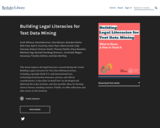
For those learning about fair use, this is a specific example of how fair use may be used in research for text data mining. The book also explores basic copyright and fair use more generally, as well as the specifics of text data mining.
From the "about" section of the book:
"This book explores the legal literacies covered during the virtual Building Legal Literacies for Text Data Mining Institute, including copyright (both U.S. and international law), technological protection measures, privacy, and ethical considerations. It describes in detail how we developed and delivered the 4-day institute, and also provides ideas for hosting shorter literacy teaching sessions. Finally, we offer reflections and take-aways on the Institute."

See Syllabus attached
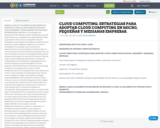
DEBIDO A QUE ACTUALMENTE SE ENCUENTRA EN REVISIÓN LA TESIS, EL DOCUMENTO ES PRIVADO POR EL MOMENTO,
PRÓXIMAMENTE SE DARÁ MAS INFORMACIÓN. GRACIAS.
La Tecnología de la Información (TI) siempre ha sido considerada un punto importante en las organizaciones empresariales, desde la perspectiva de los costos y de gestión. Es parte integral de la tecnología y los modelos de negocio de las empresas y las ha obligado a adaptarse a las nuevas estrategias de tecnología. Con los avances de infraestructura en la tecnología de la información y la comunicación, los nuevos modos de programación y los nuevos modelos en su uso; han llegado también nuevas formas de denominar los servicios de Internet. Factores como la mercantilización de hardware, software de código abierto, la virtualización, la globalización de la fuerza de trabajo y los procesos ágiles de TI han apoyado el desarrollo de nuevos modelos de tecnología y negocios. La computación en nube o Cloud Computing ofrece a las organizaciones más opciones en cuanto a cómo gestionar las infraestructuras, ahorrar costes, trabajar en equipo remotamente y delegar responsabilidades a proveedores de servicios Cloud o terceros, sin que los usuarios tengan que tener ningún conocimiento de la infraestructura que hay detrás.
La mayoría de las empresas se esfuerzan por reducir su coste del área de TI a través de los medios de virtualización. Esta demanda de reducir el costo ha dado lugar a la innovación de la computación en nube, ya que ofrece una reducción en los costos de administración así como reducción de costos de infraestructura. Los grandes beneficios del Cloud Computing permiten la adquisición de recursos computacionales de manera rápida, flexible y con un menor costo de implementación para los usuarios o empresas y es rentable para los proveedores, pues a pesar de presentar algunos riesgos, el poder trabajar con este nuevo tipo de tecnología permite al usuario ahorrarse tanto licencias, como la administración de servicios y de los equipos necesarios. Además de beneficios en términos de costo, el Cloud Computing puede presentar beneficios de seguridad ya que brinda a las empresas normas y estándares de seguridad de los más altos niveles internacionales. Incluso presenta beneficios ambientales y sociales. Todo gracias a la arquitectura conformada por los modelos con los cuales trabaja el Cloud Computing, denominadas por sus siglas: SaaS, PaaS e IaaS, las cuales corresponden al software, plataforma e infraestructura como servicios respectivamente.
El Cloud Computing se encuentra todavía en una etapa infantil y es una nueva tecnología para las micro, pequeñas, medianas o nuevas empresas. Existen pocas guías y marcos para una óptima adopción, la mayoría de ellos no se encuentran en la lengua española o no engloban todos los factores y cuestiones necesarias para generar confianza en esta tecnología. Por lo tanto, la mayoría de las empresas no están muy seguras en adoptar la tecnología. La presente tesis aborda el problema de confianza en la adopción y se discuten y analizan las barreras que se pueden presentar al adoptar la computación en nube en una empresa. Se presentan una serie de estrategias, una hoja de ruta y un marco que servirán como una guía para enfrentar los desafíos, cuestiones o factores en términos de costo, seguridad, confidencialidad, confianza, cumplimiento normativo, cumplimiento legal y cumplimento-TI, así como los factores organizacionales/humanos. En esta tesis se detallan exhaustivamente todos los temas referentes al Cloud Computing desde sus antecedentes, evolución, arquitectura, tecnología, modelos de negocio, modelos de servicio, modelos de despliegue, proveedores del servicio, etc. y así se logre un profundo entendimiento del paradigma de computación en nube. La metodología fue realizada siguiendo los lineamientos de diferentes estándares, normas, protocolos, estándares, certificados y mejores prácticas internacionalmente reconocidas respecto a la seguridad de la información en un entorno de TI ó enfocadas a entornos de Cloud Computing como: ISO/IEC 27001, ISO/IEC 27002, COBIT, ITIL, KMIP, TLS/SSL y CCSK. Esto logra una metodología con procedimientos adecuados para la adopción de Cloud Computing en las micro, pequeñas y medianas empresas que ya adoptan servicios de nube o están interesados en su adopción.
Palabras clave: Computación en Nube, Cloud Computing, SaaS, IaaS, PaaS, Costo, Cumplimiento, Seguridad, Confidencialidad, Confianza, Micro, Pequeñas y Medianas Empresas, Adopción, Estrategias.
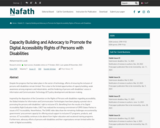
Despite the progress that has taken place in the sector of technology, efforts of ensuring the inclusion of persons with disabilities remain limited. This is due to the limited opportunities of capacity building, weak awareness among engineers and industrialists, and the hindering of persons with disabilities’ voices in Information and Communication Technology (ICT) policy development and decision-making.
Inspired by the disposition of the Convention on the Rights of Persons with disabilities regarding accessibility, the Global Initiative for Information and Communication Technologies have been playing a pivotal role in promoting the persons with disabilities’ right to inclusive ICTs. Benefiting from the results of its Digital Accessibility Right Evaluation Index, G3ICT has realized the increasing commitment of CRPD States Parties to issues of ICT Accessibility. Nevertheless, The DARE index data show the remaining challenges encountered by governments’ procurement capacity for offering actual support to inclusive ICT programs, products, and services. ICT accessibility continues to be absent from higher education and vocational training programs. Furthermore, advocacy efforts of persons with disabilities and their organizations remain limited within the realm of digital accessibility.
This paper discusses G3ICT’s Digital Accessibility Right Education (DARE) Academy, and its role in tackling issues of digital divide through offering a platform of educational development and advocacy capacity enhancement for persons with disabilities around issues of ICT accessibility.

Looking for some legal research resources? Worried about how to find and read judicial opinions? Interested in learning more about case briefs? Concerned about your prior experience with legal terms?This online resource is designed to support learners taking courses that require legal reading, writing and research.